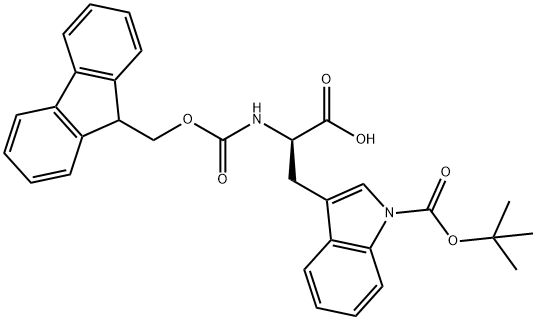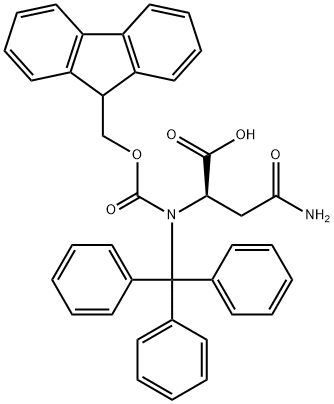Fmoc-D-Tyr(tBu)-OH
Synonym(s):Fmoc-O-tert-butyl-D -tyrosine;Fmoc-D-Tyr(tBu)-OH;N-α-Fmoc-O-t.-butyl-D-tyrosine
- CAS NO.:118488-18-9
- Empirical Formula: C28H29NO5
- Molecular Weight: 459.53
- MDL number: MFCD00065684
- SAFETY DATA SHEET (SDS)
- Update Date: 2025-07-04 16:04:00

What is Fmoc-D-Tyr(tBu)-OH?
Description
Fmoc-D-Tyr(tBu)-OH is a precursor for the synthesis of thyroxine, dopa and adrenaline in medicine. It is directly involved in the synthesis of neurotransmitters such as dopamine, norepinephrine and epinephrine, and in the control of neurotransmitter levels, and is involved in the synthesis of hormones of thyroid, pituitary and other glands. In the feed industry, Fmoc-D-Tyr(tBu)-OH can be used as a feed additive in the feed of chicks. On the one hand, it minimizes the amount of phenylalanine converted to tyrosine to maintain the balance of amino acids in the growth of livestock and poultry. On the other hand, it can avoid chicks and piglets to lose weight due to insufficient tyrosine in the body and the destruction of thyroid and adrenal hormones.
Chemical properties
White powder
The Uses of Fmoc-D-Tyr(tBu)-OH
N-Fmoc-O-tert-butyl-D-tyrosine is potentially useful for proteomics studies and solid phase peptide synthesis techniques.
What are the applications of Application
Fmoc-D-Tyr(tBu)-OH is an Fmoc protected tyrosine derivative
Definition
Fmoc-D-Tyr(tBu)-OH (5mM) forms sphere-like assemblies at room temperature which may be converted to fibers-like structure on heating at 70 0C. In the case of Fmoc-D-Tyr(tBu)-OH, it formed a destructive aggregate at lower concentration instated of fibrils structure.
Benefits
Taking Fmoc-D-Tyr(tBu)-OH can have an impact on the regulatory effects of mental, physical, metabolic, skin, growth rate, and psychology. It mainly has a good improvement effect on long-term fatigue, drowsiness, boredom, depression, frigidity, allergic reactions (allergies), headaches, anti-hunger, anti ultraviolet radiation, weight loss, blood pressure, Parkinson's disease, memory enhancement, attention deficit disorder, dementia, benzophenone medication, hangover, and mental stimulation in people
Properties of Fmoc-D-Tyr(tBu)-OH
| Melting point: | 150.0 to 154.0 °C |
| Boiling point: | 658.2±55.0 °C(Predicted) |
| Density | 1.218±0.06 g/cm3(Predicted) |
| storage temp. | 2-8°C |
| solubility | Soluble in Chloroform,Dichloromethane,Ethyl Acetate,DMSO,Acetone,etc. |
| form | powder to crystal |
| pka | 2.97±0.10(Predicted) |
| color | White to Almost white |
| Water Solubility | Soluble in 1 mmole in 2 ml dimethylformamide (Clearly soluble). Slightly soluble in water. |
| BRN | 6691868 |
| CAS DataBase Reference | 118488-18-9(CAS DataBase Reference) |
Safety information for Fmoc-D-Tyr(tBu)-OH
Computed Descriptors for Fmoc-D-Tyr(tBu)-OH
| InChIKey | JAUKCFULLJFBFN-RUZDIDTESA-N |
| SMILES | C(O)(=O)[C@@H](CC1=CC=C(OC(C)(C)C)C=C1)NC(OCC1C2=C(C=CC=C2)C2=C1C=CC=C2)=O |
Fmoc-D-Tyr(tBu)-OH manufacturer
New Products
Indole Methyl Resin tert-butyl 9-methoxy-3-azaspiro[5.5]undecane-3-carboxylate Boc-His(Boc)-OH 2-CTC Resin 4-Chloro-7-tosy1-7Hpyrrolo[2,3-d]pyrimidine 5,7-Dibromo-1H-indole 2,5-dichloro-N-hydroxy-4,6-dimethylpyridine-3-carboximidamide 2,2-Dimethoxy-7-azaspiro[3.5]nonane hydrochloride 4-chloromethyl-5-methyl-1,3-dioxol-2-one (DMDO-Cl) R-2-BENZYLOXY PROPIONIC ACID 1,1’-CARBONYLDIIMIDAZOLE 1,1’-CARBONYLDI (1,2-4 TRIAZOLE) N-METHYL INDAZOLE-3-CARBOXYLIC ACID 4-((2-hydroxyethyl)thio)benzoic acid 1-(TERT-BUTOXYCARBONYL)-2-PYRROLIDINONE Methyl 6-methylnicotinate 3-Pyridineacrylic acid tert-Butyl carbazate TETRAHYDRO-2H-PYRAN-3-OL 2-((4-morpholinophenylamino) (methylthio) methylene) malononitrile 3-(4-morpholinophenylamino)-5-amino-1H-pyrazole-4-carbonitrile 2,4-dihydroxybenzaldehyde 1,3-Diethyl-1,3-Diphenylurea Methyl 2-methylquinoline-6-carboxylateRelated products of tetrahydrofuran








You may like
-
![Nα-[(9H-Fluoren-9-ylmethoxy)carbonyl]-O-tert-butyl-D-tyrosine CAS 118488-18-9](https://img.chemicalbook.in//Content/image/CP5.jpg) Nα-[(9H-Fluoren-9-ylmethoxy)carbonyl]-O-tert-butyl-D-tyrosine CAS 118488-18-9View Details
Nα-[(9H-Fluoren-9-ylmethoxy)carbonyl]-O-tert-butyl-D-tyrosine CAS 118488-18-9View Details
118488-18-9 -
 Fmoc-D-Tyr(tBu)-OH, ≥98% (HPLC) CAS 118488-18-9View Details
Fmoc-D-Tyr(tBu)-OH, ≥98% (HPLC) CAS 118488-18-9View Details
118488-18-9 -
 Fmoc-D-Tyr(tBu)-OH 95% CAS 118488-18-9View Details
Fmoc-D-Tyr(tBu)-OH 95% CAS 118488-18-9View Details
118488-18-9 -
 Fmoc-D-Tyr(tBu)-OH CAS 118488-18-9View Details
Fmoc-D-Tyr(tBu)-OH CAS 118488-18-9View Details
118488-18-9 -
 Fmoc-D-Tyr(tBu)-OH CAS 118488-18-9View Details
Fmoc-D-Tyr(tBu)-OH CAS 118488-18-9View Details
118488-18-9 -
 Fmoc-D-Tyr(TBU)-OH , CAS NO 118488-18-9View Details
Fmoc-D-Tyr(TBU)-OH , CAS NO 118488-18-9View Details
118488-18-9 -
 Pyridine 99.5% HPLC /UV SpectroscopyView Details
Pyridine 99.5% HPLC /UV SpectroscopyView Details
110-86-1 -
 Thiourea 99% ARView Details
Thiourea 99% ARView Details
62-56-6
